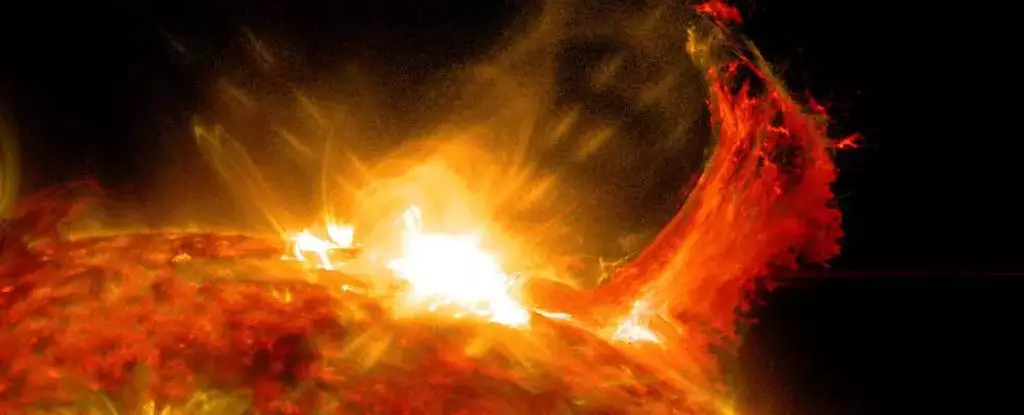The Sun, often depicted as a serene beacon of light and life in our solar system, harbors a more tumultuous reality beneath its glowing facade. Continuous activity, such as violent flares and magnetic disruptions, defines its nature as a dynamic star. While the majority of this solar activity poses little threat to Earth, the potential for catastrophic superflares raises significant concerns among scientists. Recent studies indicate that these powerful eruptions may occur more frequently than previously believed, prompting the scientific community to reevaluate the implications of such events on life as we know it.
Traditionally, scientists estimated that the Sun might unleash a superflare only once every one hundred to one thousand years. However, with new analysis focusing on over 56,000 stars similar to our Sun, researchers have concluded a sobering average of once every century. This alarming revelation casts a shadow over our technological infrastructure, as even historical solar events with lesser intensity have caused significant disruptions. The Carrington Event of 1859, for instance, was just a fraction of a superflare’s potential power and yet was able to disrupt telegraph systems worldwide, igniting fears of future cosmic tempests.
Vasilyev and fellow researchers emphasize that understanding the frequency of solar explosions is inherently complex. Tracking solar activity requires innovative techniques, as scientists cannot simply observe the past directly. Carbon-14 levels in tree rings provide some insights, correlating increased solar activity with isotopic changes, yet this method may not capture the entire spectrum of solar outbursts. To improve data accuracy, researchers have focused on stars categorized as G-type yellow dwarfs, similar to the Sun, to model flare activities better and assess their cosmic ramifications.
The study’s design navigated around the challenge of measuring stellar rotation. As solar flares are thought to correlate with a star’s rotational activities, the challenge posed a daunting barrier. Young stars tend to rotate more freely and are associated with heightened solar activity, presenting a distinct advantage for researchers. Vasilyev and the team concentrated on acquiring a representative sample by filtering for stars exhibiting similar brightness and temperature to our Sun while broadening the scope to include those with unmeasured rotation periods. The outcome was impressive: 2889 superflares observed on 2527 different stars. This comprehensive data suggests an ordinary occurrence of superflares every hundred years—a staggeringly high frequency.
Despite the intimidating statistics, the exact relationship between solar flares and their subsequent effects remains uncertain. Research suggests that not all powerful flares are accompanied by coronal mass ejections (CMEs)—the solar phenomena most damaging to technological systems on Earth. Each CME has the potential to induce electromagnetic currents powerful enough to disrupt electrical grids, as demonstrated by the minor geomagnetic storms of 1989 that resulted in widespread blackouts. The historical context of Miyake events—events identified in ancient tree rings—hints at even more powerful solar phenomena, with projections suggesting occurrences approximately every millennium.
Scientific inquiry into these relationships is crucial, as the potential consequences of a superflare combined with a CME could be catastrophic. Experts like astrophysicist Ilya Usoskin highlight the need for further investigation to detail how superflares interact with solar particle events, as our future infrastructure and technological frameworks may depend heavily on understanding these cosmic alignments.
Ultimately, the Sun’s unpredictable nature underscores a pressing need for advanced forecasting capabilities. As solar-powered technology becomes more embedded in everyday life, understanding the Sun’s behavior is not merely an academic pursuit; it is a necessary step in safeguarding our civilization against potential stellar wrath. Scientists like Natalie Krivova remind us that solar phenomena are part of the Sun’s natural activity spectrum, emphasizing that preparedness and accurate forecasting are our best defenses against disastrous geo-magnetic storms.
Given the complexity and potential risk of solar activity, it is vital for ongoing research efforts to focus on refining our models and predictive capabilities. A proactive approach to studying the Sun can help us mitigate risks associated with powerful solar events and protect not only our technological infrastructures but the continued viability of our societal systems amidst the whims of our volatile star. By bridging the knowledge gap surrounding solar activity, humanity can harness the Sun’s energy while remaining vigilant against its more perilous outbursts.


Leave a Reply